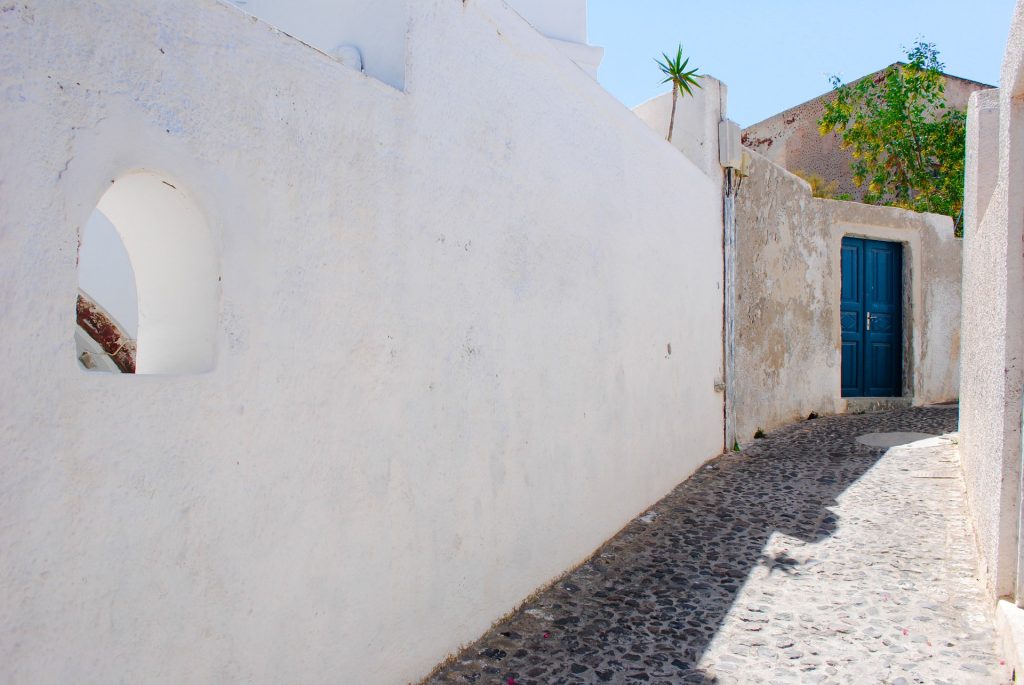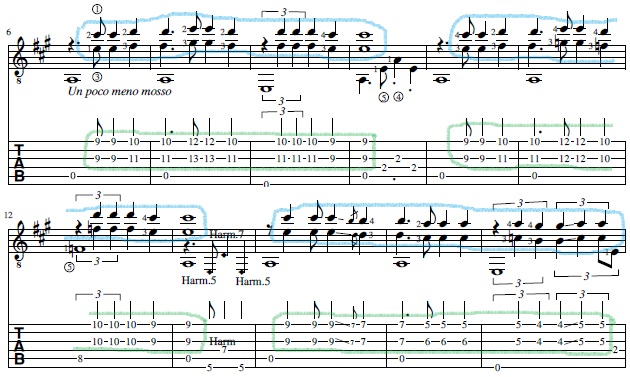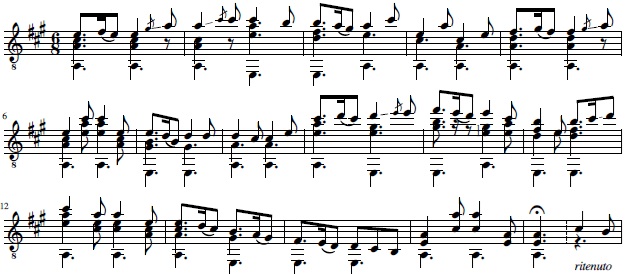Improve The Harmonies
Aug. 27, 2025

In “Start with Melody“, I explained the process of creating a song in the order of melody, harmony, bass, and rhythm. But the method of creating harmony I described was simple.
Here, I will write about further improvements I have made to harmony.
There are two main topics I’ll be talking about here. One is “harmony that follows the melody” and the other is “harmony that moves the song forward.” First, I’ll talk about harmony that follows the melody.
In the case of “harmony that follows the melody”, I often write two-note harmonies that include the melody, except for the bass. This is because the melody is the main focus, so the other notes are better not to be too many. And the melody should be highest note in order to stand out, so the choice of the added notes are how many steps below the melody.
This is an example of 3rd-below harmony. They are marked in blue and green. The added notes are played on the next lower string than the melody.
Oh! Italia ; 1st phrase
The next is 6th-below harmony. In this case, the added notes are played on two lower string.
Alley Walk – Alley Illusion ; 2nd phrase
And the next example is 4th-below harmony. The added notes are played on one lower string.
Garden of Plum Blossom ; 1st phrase
The purple-marked notes are not a 4th-below, but the melody has been shifted relative to the previous note, and they are played with the feeling that only the melody has moved while the same harmony continues to play.
As in the these examples, I often use the same pitch difference harmony within a phrase. This isn’t something I do intentionally, it just comes naturally, but I think it’s because there is a certain feeling that the difference in pitch creates, and I want to keep the feeling, at least within the same phrase.
To me, 3rd-below give the most orthodox feel to Western music, so when I try to create music in the normal way, I choose it.
6th-below add depth to the sound and give it a sense of nostalgia and heaviness, so I use them when I want to leave that kind of impression.
4th-below… I don’t know what it is. The only song I actually used it extensively was Garden of Plum Blossom. However, when I started composing this song, the moment I played it with this harmony, the atmosphere took on an oriental feel. From a Western musical perspective, this harmony may be “unusual,” and perhaps that is what gives it an Eastern feel.
I have never consciously used 5th-below harmony. When I play it, it creates a unique sound. I might try using it someday.
The second topic is “harmony that moves the song forward.” With “harmony that follows the melody” policy, the melody is the main focus and harmonies are added to make the sound richer. However with “harmony that moves the song forward” policy, the song is driven forward by chords played on many strings. Below is an example. You can see that chord playing is the main focus, as there are four notes lined up vertically everywhere.
Mount Adatara ; 1st phrase
And below is another example.
Lunch at Café ; Coda
Songs that the chords push the song forward are easy to play, so it can be played vigorously. It’s a great fun.
“Harmony that follows the melody” and “harmony that moves the song forward” are very different approaches to make a song. These are options for composing music.
Up to this point, I have talked about how to create harmony within a single phrase of a song, but when it comes to the song as a whole, it is a matter of combining those phrases.
Below is the whole song of Alley Walk – Alley Illusion. In the beginning, I used 3rd-below harmonies to express the walking in reality, but halfway through, I changed the harmony to 6th-below in order to express the transition from reality to fantasy. And in the middle part, I changed rhythm and key to express the illusion of the views. For this part, I used 3rd-below harmony, which sounds beautiful. Finally, I return to reality by Da Capo, only to be pulled back into fantasy before I know it.
⇒Alley Walk – Alley Illusion: Staff Notation ↗️
Another example is Mount Adatara. To express the majestic mountain scenery, I initially drove the song forward by inserting chords that sounded four strings simultaneously twice per measure in time with the beat. And in the middle part, I used soft arpeggio to express the mysterious lakes.
⇒Mount Adtara: Staff Notation ↗️
Changing the type of the harmony to suit what I want to express is a fun of composing.
← Progress By Bass / Incorporate Solo Melody →
Photo by SofiaPapageorge on Pixabay
